Japan
Wood Products Prices
Dollar Exchange Rates of 25th
July
2025
Japan Yen 147.65
Reports From Japan
Ruling coalition looses its majority
At the recent election Japan's ruling coalition lost its
majority in the country's Upper House. Having already lost
its majority in Japan's more powerful lower house last
year, the defeat will undermine the coalition's influence.
The LDP/Komeito centre-right coalition has governed
Japan almost continuously for decades.
Obserevrs say the election result underscores highlights
voter frustration with the administration that has struggled
against economic headwinds, a cost-of-living crisis and
trade difficult negotiations with the United States.
.
See: https://www.bbc.com/news/articles/c8xvn90yr8go
An agreement in principle
Japan and the United States reached a trade deal with the
“reciprocal” tariff rate set at 15%. There is little
information on sector-specific tariffs.
The local media reported the overall tariff rate on
automobiles will be 15%. The US has claimed this deal
will create thousands of jobs in the US adding that Japan
will open their market to US cars and trucks, rice and
certain other agricultural products.
The Japanese Prime Minister said at a news conference
that he believes this will contribute to Japan and the
United States working together to create jobs and promote
high-quality manufacturing, thereby fulfilling various
roles on the global stage.
Tsutsui Yoshinobu, head of Japan's leading business
lobby, welcomed the trade agreement with the United
States but voiced concern over the current state of the
global economy.
Tsutsui Yoshinobu became the new chairman of the Japan
Business Federation, (Keidanren) in late May.
Tsutsui said that he highly evaluated the terms of the
bilateral deal. But he added it came at a time when the
world is at a major turning point with the Japanese
economy facing many challenges.
When the tariff agreement was announced Japan’s
benchmark Nikkei 225 stock index rose about 2% and the
yen strengthened.
Shinichiro Kobayashi, Principal Economist at Mitsubishi
UFJ Research and Consulting said the deal is positive as it
has removed uncertainty it provides only brief relief as
tariffs remain at higher levels than before threatening
recovery in Japan's inflation-plagued economy.
A senior economist at Daiwa Institute of Research says the
trade agreement between Japan and the US will hurt
Japan's economy and that the impact of tariffs on trade
with the US may reduce Japan's GDP by 1.1% in real
terms this year.
See:
https://www.japantimes.co.jp/business/2025/07/23/economy/us-
japan-trade-deal-trump/
and
https://mainichi.jp/english/articles/20250724/p2g/00m/0bu/0290
00c
EU and Japan to expand trade ties
The European Union and Japan have agreed a so-called
“competitiveness alliance” to expand bilateral trade ties,
promote business cooperation and explore ways to
diversify critical mineral supply chains. This comes as
both sides face increased economic pressure from the US.
The alliance, which will also include an “upgraded”
economic dialogue in a format similar to what are known
as two-plus-two talks involving senior officials, was
among a series of agreements reached.
The European Commission commented “Together, Europe
and Japan represent a fifth of global GDP and a market of
600 million people, so we have the scale to shape global
rules on trade and technology in line with our values of
fairness and openness”.
The alliance framework rests on three pillars: increasing
bilateral trade, strengthening economic security and
working together more closely on innovation as well as the
green and digital transitions.
The partners also agreed to step up coordination and
jointly lead international discussions, for example, by
steering trade-related talks at meetings of the World Trade
Organization (WTO) and through the expanded economic
dialogue, which will now include Stephane Sejourne, the
EU Commission’s Executive Vice President for Prosperity
and Industrial Strategy. The two sides will aim to identify
strategic goods and sectors, while addressing economic
coercion and nonmarket policies and practices.
Under their new alliance, Japan and the EUs also plan to
simplify and streamline rules to reduce administrative
burdens for Japanese and European businesses and citizens
while deepening industrial policy cooperation and
facilitating investment and business collaboration.
Other objectives of the new framework include promoting
and protecting critical and emerging technologies,
enhancing research security as well as the physical and
cybersecurity of critical infrastructure.
Finally, the EU's new ‘Competitiveness Compass’
positioned innovation, decarbonisation and dependency
reduction as growth pillars where Japan emerges as the
bloc’s “natural technological and values-based partner.
EU-Japan relations are based on a strategic partnership
agreement and a free-trade deal that has been in force
since 2019. EU firms already export nearly €70 billion
(US$81.8 billion) in goods and €28 billion (US$32.7
billion) in services to Japan every year.
See:
Ahttps://www.japantimes.co.jp/business/2025/07/23/economy/ja
pan-eu-economic-
cooperation/?utm_source=pianodnu&utm_medium=email&utm_
campaign=72&tpcc=dnu&pnespid=_ehpmdie_kfi_kayq0_27p4k
vq8msjfshwa4bvi6t0cvzvkziz5q9v6roxs8vohynddewq
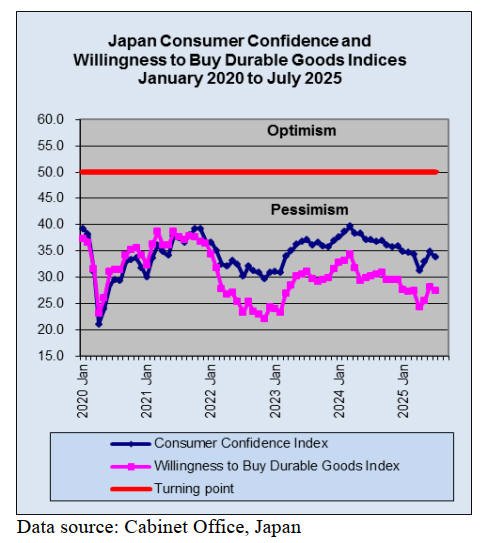
Bank of Japan holds rates steady
The yen strengthened slightly after the Bank of Japan
(BoJ) maintained its stance on interest ratesat the end of
July however, the BoJ did raise its inflation forecast for
the current fiscal year. At the end of July the yen was at
between 145-149 against the US dollar.
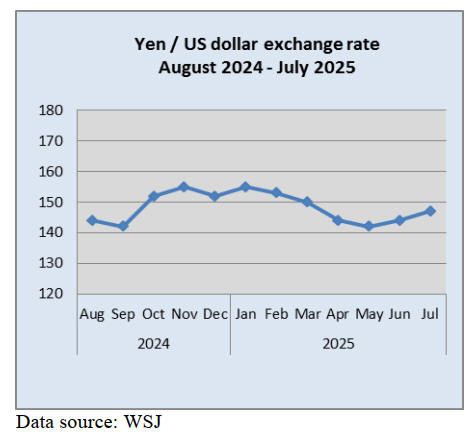
Volatility in the housing sector
In April 2025 housing starts plummeted to 56,188 units, a
37% drop from March's unusual surge and marked a 27%
year-on-year decline. This sharp reversal from March
underscores the fragility of a sector now caught between
cyclical volatility and an irreversible slowdown.
Japan's housing crisis is rooted in its shrinking population.
With 8 million abandoned homes (14% of total housing
stock) and projections of over 20 million vacant units by
2033. Even if immigration reforms attract 800,000 foreign
workers by 2029 this will barely offset annual population
losses.
Fewer households mean fewer buyers and it gets worse
overtime as construction costs continue to rise due to
labour shortages. Real estate prices, up almost 3% in early
2024 have stagnated after inflation adjustments. This
“price ceiling” traps developers in a low-margin, high-risk
situation, say analysts.
The AInvest website comments that “Japan's housing
market is entering a “new normal” of low starts, over-
supply and demographic decline”.
See: https://www.ainvest.com/news/japan-collapsing-housing-
market-navigating-structural-decline-cyclical-volatility-2505/
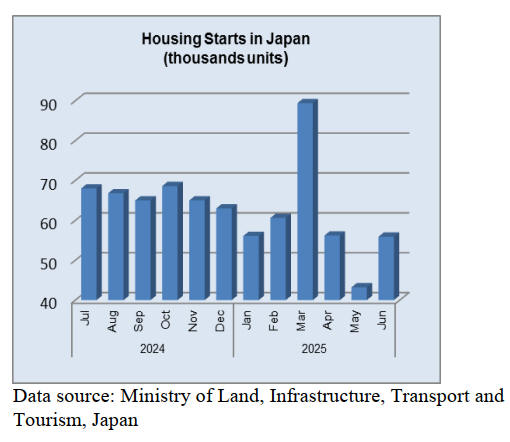 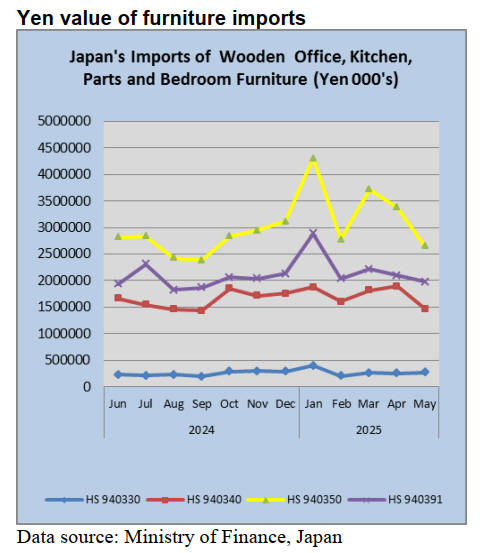
May wooden office furniture imports (HS940330)
In May shippers in China accounted for 86% of Japan’s
imports of wooden office furniture (HS940330) the other
significant sources were the UK (45%) and Malaysia
(3%). May shipments from suppliers in China were up
11% while those from shippers in Malaysia were down
around 6% month on month. Shippers in the UK were a
new addition to sources in May.
These three shippers accounted for over 90% of May
arrivals. The other source of wooden office furniture
imports was EU member countries (around 9%) with the
balance coming from Italy and Vietnam.
Year on year, the value of Japan’s imports of wooden
office furniture in May were down 9% but compared to
the value of April arrivals there was an 8% increase.

May wooden kitchen furniture imports (HS940340)
As in previous months imports of wooden kitchen
furniture (HS940340) were dominated by shippers in the
Philippines and Vietnam which together accounted for
over 80% of the value of May arrivals.
Shippers in the Philippines accounted for around 51% of
total arrivals in May, down 6% from a month earlier.
Imports from shippers in Viet Nam accounted for a further
30% also down sharply (20%) month on month.
May arrivals from China were at around the same level as
in April but arrivals from Germany, previously a
significant supplier of HS940340, drooped over 50%.
Year on year there was 10% decline in the value of
wooden kitchen furniture imports and compared to the
values of April arrivals there was a 22% decline.
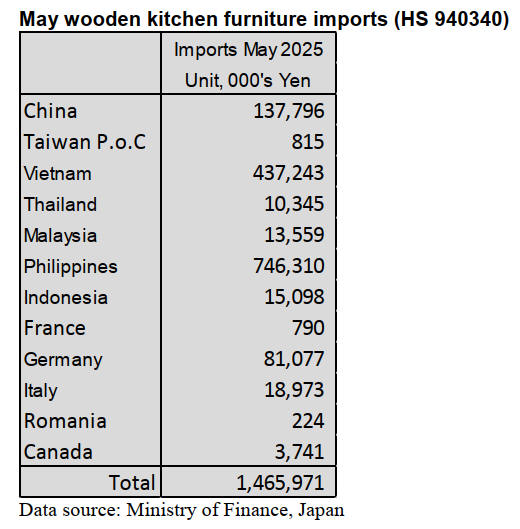
May wooden bedroom furniture imports (HS 940350)
May marked a steading of the value of imports of
HS940350 after a volatile start to the year.
The top two shippers of HS940350 to Japan in May were
China, 64% of the total but down 6% month on month and
Viet Nam, 29% but down 37% month on month. Malaysia
and Thaiand were the other shippers of note in May
together accounting for around 6% of the value of arrivals.
Year on year there was a 19% decline in the value of
wooden bedroom furniture in May and compared to April
arrivals in May were down 22%.
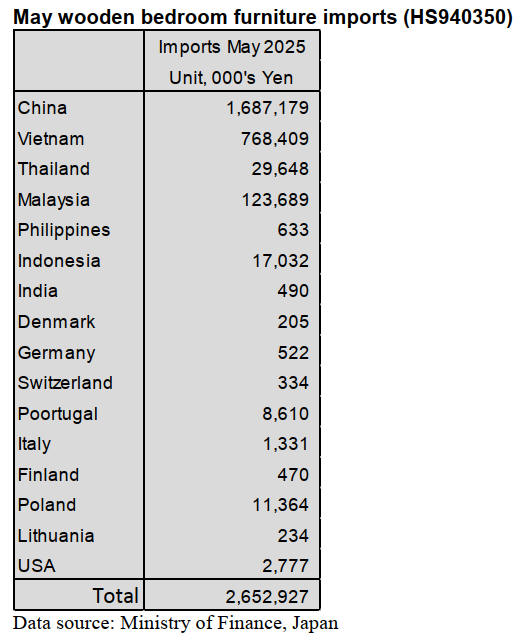
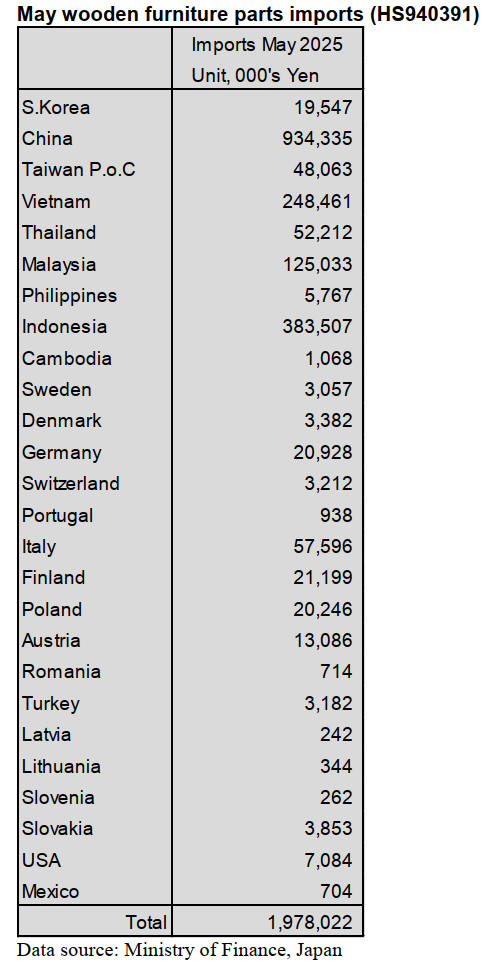
May wooden furniture parts imports (HS 940391)
In May there was a further decline in the value of wooden
furniture parts imports and this was the second monthly
decline. The value of May 2025 imports was almost the
same as in April 2024 and compared to May 2024 there
was little change.
Shippers in China, Indonesia, Viet Nam and Malaysia
accounted for most of Japan’s imports of wooden furniture
parts (HS940391) in May 2025. Of the total value of
HS940391 imports 47% was delivered from China (50%
in April) 19% from Indonesia (17% in April March), 12%
from Viet Nam (13% in April) and Malaysia which
secured a 5% share of May imports.
The value of imports of HS940391 from Italy and
Germany rose in May and there was a rise in the value of
imports from the US.
Trade news from the Japan Lumber Reports (JLR)
The Japan Lumber Reports (JLR), a subscription trade
journal published every two weeks in English, is
generously allowing the ITTO Tropical Timber Market
Report to reproduce news on the Japanese market
precisely as it appears in the JLR.
For the JLR report please see:
https://jfpj.jp/japan_lumber_reports/
Russian lumber becomes the third major raw material
APT-Shinko Co., Ltd. in Toyama Prefecture, one of major
red pine lumber manufacturers in Japan, has announced its
plan to position Russian red pine lumber as a “third raw
material.” Alongside lumber sourced from semi-processed
boards, currently considered the second raw material, the
company aims to enhance customer satisfaction by
offering a broader range of Russian sawn timber products.
The company consumes 2,000 cbms of Russian semi-
processed boards monthly and imports 800 – 1,000 cbms
of Russian lumber monthly.
The company exclusively imports 3 or 4 metre, 30 x 40
KD taruki for the Japanese market from Vitim, a Russian
manufacturer and re-sorts the products according to its
own grading standards. At the same time, it has also begun
selling the lumber to other companies that handle general
Russian timber.
Radiata pine lumber from Chile
For the third shipment of Chilean radiata pine lumber
scheduled for July 2025, CMPC, which had previously
shared bulk shipping with Arauco, has shifted its Japan-
bound shipments from bulk vessels to container shipping.
As a result, Arauco became the sole operator of the
shipment.
The two companies had jointly operated shipping services
for over 20 years, but due to a slowdown in international
trade caused in part by the Trump tariffs, CMPC opted for
container shipping this time.
With demand for packaging-grade radiata pine lumber
remaining unclear, all eyes are on whether CMPC will
stick with container shipping. Nonetheless, suppliers plan
to ensure a steady supply.
Orders for house builders
The orders at many major housing companies and house
builders in May, 2025 do not exceed the orders in May,
2024. There is also a reactionary decline following the
increase in orders in March, 2025. However, companies
that put effort into sales promotion were able to attract
more visitors to their showrooms and increase their orders.
Major companies have not yet seen any significant impact
from the March revision of the Building Standards Act,
and it appears that most are proceeding smoothly with
building permit applications. However, there is skepticism
as to whether things will continue without impact going
forward.
While sales of detached houses remain steady in major
metropolitan areas, they have been sluggish in regional
cities. Order trends for multi-unit housing vary across
companies. For some companies, the order value for
multi-family housing has declined by more than 10%
compared to the same month of the previous year. Orders
for renovation projects remained steady. Notably, some
companies recorded around a 10% year-on-year increase
in order value for May.
Domestic lumber and logs
In the Kanto market, the sense of tight supply for green
domestic products is intensifying. 4 m x 90 mm cedar
square lumber is around 35,000 yen, delivered per cbm
and this is 3,000 - 5,000 yen higher than the past few
months. Sawmills are quoting prices in the range 38,000
yen to 40,000 yen, per cbm.
Supply of 3, 3.65, and 4-meter lengths × 13–18 × 45 or 90
mm furring strip has also declined, with central market
prices across the Kanto hovering around 45,000 yen per
cbm - an increase of approximately 3,000 yen over the
past few months.
A growing sense of shortage is also being felt for thin
board (12×150, 180, 225 × 1,820 mm boards).
The central market price has risen to 33,500 - 38,000 yen,
marking an increase of 3,000 - 5,000 yen.
As this is a season when log insect damage is more likely
to demand particularly for medium- diameter logs—has
weakened. Cedar log for post is 15,000 delivered per cbm
in Tochigi Prefecture and this is 1,400 yen more than last
month. In Okayama Prefecture, cypress log for post is
25,500 yen and this is 2,500 yen more than last month.
In Kyushu region, cedar log for post is 16,000 yen,
delivered per cbm. 15,000 – 16,000 yen, delivered per
cbm, in Akita Prefecture. Cypress log for sill is 24,000
yen, delivered per cbm, in Kyushu region and is 23,000
yen, delivered per cbm, in Tochigi Prefecture.
Cypress log for post is 23,800 yen, delivered per cbm,
Tochigi Prefecture and it is 22,400 yen, delivered per cbm,
in Shikoku area.
The price of a log for plywood in Tohoku Region is weak
but prices remain elevated in western Japan. Inquiries for
exporting logs in the southern part of Kyushu region are
sluggish.
|